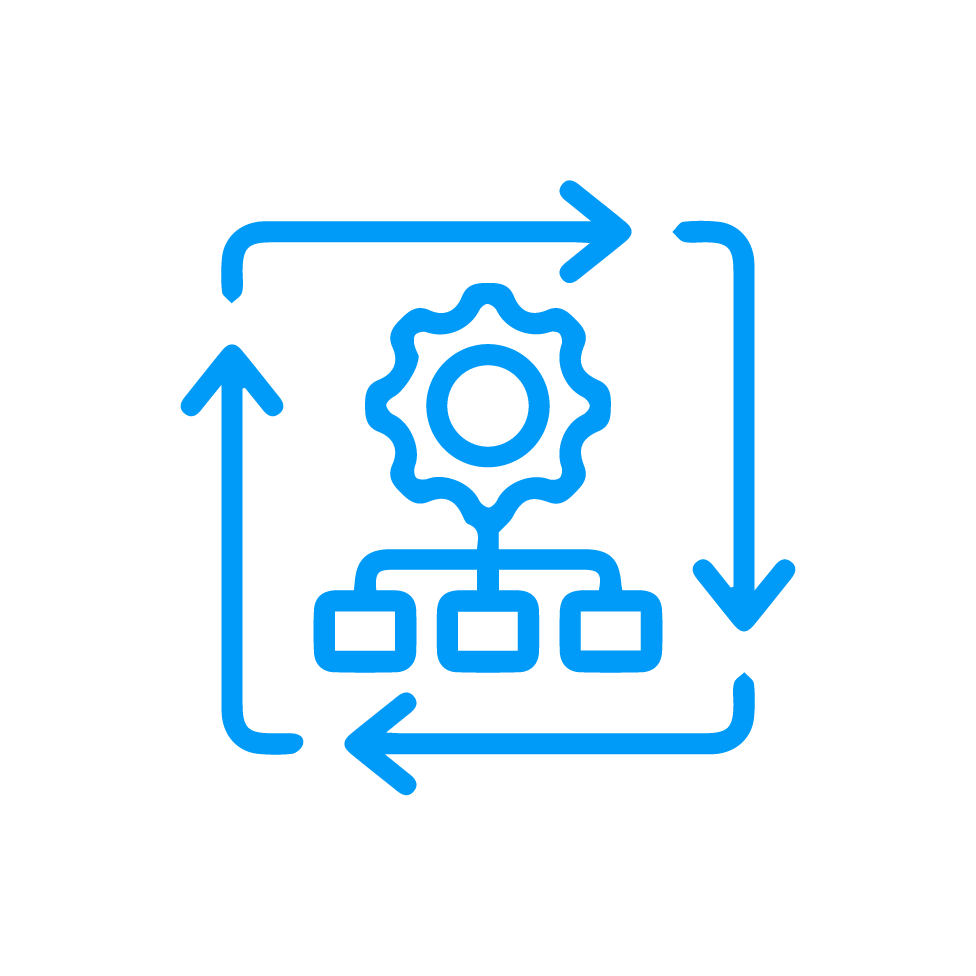DevOps
Success is coded into every deployment with our solutions
Introduction
Welcome to STG, your catalyst for DevOps transformation. In today’s business landscape, speed and agility are paramount. Our DevOps Services are tailored to break down silos, accelerate development cycles, and enhance collaboration between development and operations teams. We’re not just implementing tools but fostering a cultural shift that drives innovation, efficiency, and excellence in your software delivery pipeline. Embrace the future of development and operations with our comprehensive DevOps solutions.

Core Elements
DevOps aims to address the challenges posed by traditional software
development methods.

Collaboration
DevOps encourages close collaboration between development teams responsible for writing code and operations teams responsible for deploying and maintaining applications. This collaboration fosters a shared sense of ownership and responsibility.

Automation
Automation plays a pivotal role in DevOps. It involves automating repetitive tasks, such as code builds, testing, and deployment, to ensure consistency, reduce errors, and accelerate the software delivery pipeline.

Continuous Integration (CI)
Developers frequently integrate code changes into a shared repository. Automated tests are run to detect and address any integration issues early in development.

Continuous Delivery (CD)
Automated testing and deployment processes enable code changes to be rapidly moved through different stages of testing and ultimately deployed to production environments.

Monitoring and Feedback
Continuous monitoring of applications in production helps identify issues early and provides valuable feedback to development teams. This feedback loop contributes to the continuous improvement of both applications and processes.

Infrastructure as Code (IaC)
DevOps practices often involve treating infrastructure as code, allowing teams to manage and provision infrastructure through code and version control, enhancing consistency and reproducibility.

Cultural
Shift
DevOps is not only about tools and processes but also a cultural shift towards collaboration, transparency, and shared goals among teams.
Services Offered Details
Learn More
Learn More
Learn More
Learn More
Learn More
Learn More
Learn More
Learn More
Selling point
Our STG DevOps experts are dedicated to transforming how you develop, deploy, and manage software applications. By integrating development and operations, we enable reliable software delivery, enhance collaboration, and drive continuous innovation.
- Reducing the time between writing code and making it available to users.
- Minimizing the risk of deploying faulty code to production by relying on automated testing and increasing the frequency of software releases to deliver new features and bug fixes more rapidly.
- Detect integration issues early by automatically building and testing code changes in an isolated environment.
- Ensure that code changes don’t introduce regressions or conflicts with existing code and improve collaboration among team members by making sure everyone’s code is consistently integrated.
Insights
Symphony Of Success: A Case Study On Microservices Orchestration For Collaborative Scaling
Urban Renaissance: Transforming Cities Through Data-Driven Sustainability
Data Symphony: Navigating Mergers And Acquisitions Through Seamless Data Integration
Fortifying The Chain: A Case Study On Safeguarding Against Ransomware Threats In Vendor Networks
Seamless Health Monitoring: A Case Study On Designing Intuitive UI For Wearable Health Tech
Closing The Loop: A Case Study On Circular Economy Analytics
Safeguarding Transactions: A Case Study On AI-Enhanced Fraud Detection in E-commerce
The Healthcare Data Symphony: A Revolution through User-Friendly Interface
AI in Retail: Crafting Unique Experiences
Integration vs. Modernization – Navigating the IT Landscape

“Thanks to STG’s DevOps services, our development and operations teams are now seamlessly aligned. The continuous integration and delivery practices introduced have accelerated our software release cycles, and the cultural shift towards agility has fostered a more collaborative and innovative environment.”
– Zachary Chism, DevOps Engineer
AWS CodeBuild
An integral part of Amazon Web Services, is a managed continuous integration service designed to compile, build, and test source code automatically. It offers a range of advantages that significantly enhance STG’s software development practices.
- AWS CodeBuild brings about several key benefits. Firstly, it enables the automation of the build and testing phase of software development. As developers commit their code changes to the repository, CodeBuild kicks in, compiling the code, and running tests. This automation eliminates the need for manual intervention in the build process, leading to reduced human errors and consistent build outcomes.
- Our Developers configured CodeBuild to work with a variety of programming languages, build tools, and testing frameworks. Moreover, CodeBuild seamlessly integrates with other AWS services and tools. It can be easily integrated into a CI/CD pipeline using services like AWS CodePipeline or as part of a custom workflow. This integration allowed STG to create a comprehensive development and deployment process that aligns with unique requirements.
- Through the adoption of AWS CodeBuild, STG focused more on developing high-quality applications and less on managing build complexities.
- Similarly, STG used Azure DevOps, a set of development tools that includes Azure Pipelines (CI/CD), Azure Repos (source control), Azure Boards (work tracking), and Azure Test Plans (testing).



Continuous Delivery (CD): Our CD pipelines automate the deployment of code changes to production or staging environments. This minimizes human errors, reduces deployment time, and enables frequent releases.
The objectives of CD include:
– Reducing the time between writing code and making it available to users.
– Minimizing the risk of deploying faulty code to production by relying on automated testing and increasing the frequency of software releases to deliver new features and bug fixes more rapidly.
Here are some CD tools and how they are used by our STG developers on some of the cloud platforms:
AWS CodeDeploy, a core component of Amazon Web Services, is a fully managed deployment service designed to automate application deployments to a variety of compute services, ensuring efficient and reliable delivery of software changes. By using AWS CodeDeploy, STG implemented a variety of deployment strategies. These strategies allowed us to fine-tune the way changes were rolled out, mitigating risks and ensuring a smooth transition for end-users.
When developers make changes to the application codebase, CodeDeploy automates the process of deploying these changes across multiple instances, servers, or containers. This automation minimizes human errors, expedites the deployment cycle, and guarantees consistent and repeatable deployments.
It can be easily combined with AWS CodePipeline for end-to-end CI/CD automation or integrated into custom deployment scripts and processes.
In conclusion, AWS CodeDeploy empowered us by automating and optimizing the deployment phase of software development. This leads to faster and more reliable releases, ultimately enhancing STG’s agility and ability to respond to client needs.
Similarly, Azure Functions, a service provided by Microsoft, and Google Container Registry, offered by Google Cloud, are two powerful tools that cater to specific aspects of application development and deployment.
For STG, Azure Functions, and Google Container Registry offer distinct advantages that significantly optimize our development and deployment practices. Azure Functions is a serverless compute service that enables us to develop and deploy event-driven, small-scale applications. Developers wrote code snippets that respond to events, such as HTTP requests or database updates. This approach accelerated development, minimized overhead, and allowed us to focus on creating functionality rather than managing infrastructure.
On the other hand, Google Container Registry provides a centralized repository for storing, managing, and distributing container images. Containers package an application and its dependencies, ensuring consistency across various environments. STG used tools like Docker to create containerized applications, and then store those containers in the Google Container Registry. This simplifies deployment by ensuring that the application runs consistently across different stages, from development to production.
In summary, the combined use of Azure Functions and Google Container Registry empowered us with a versatile approach to application development and deployment. While Azure Functions cater to lightweight, event-driven functionalities, Google Container Registry ensures consistency and reliability across different deployment stages using containerization.
STG strategically employed Vagrant to significantly enhance development and testing processes. Vagrant is an open-source tool that simplifies the creation and management of virtualized development environments, making it easier to replicate production-like setups for development and testing purposes.
Firstly, Vagrant enabled development teams to create consistent and reproducible development environments effortlessly. This consistency eliminated the “it works on my machine” problem and ensured that everyone was working in the same environment, leading to fewer integration issues and faster development cycles.
Secondly, Vagrant supported multi-provider compatibility, allowing us to create development environments that closely mimic various production infrastructure setups, whether on local virtualization platforms or in cloud environments. This flexibility enabled teams to test and develop against different target environments easily. Additionally, Vagrant seamlessly integrated with configuration management tools like Ansible, Puppet, and Chef, enabling to provision and configuration of development environments automatically.
STG is well-equipped to assist you in implementing Vagrant effectively, tailoring it to your specific business needs, and ensuring that your development processes run smoothly while aligning with your strategic objectives.
Infrastructure as Code (IaC)
We utilize IaC principles to define and manage your infrastructure using code. This approach ensures consistency, repeatability, and scalability of your environments.
Here are some IaC tools and how they are used by our STG developers on some of the cloud platforms:
Learn More
Learn More
Learn More
Learn More
Configuration Management
Our experts use Configuration Management tools to maintain and update software configurations across various environments. This guarantees consistency and reduces configuration-related issues.
Here’s an overview of configuration management tools and how they are used by our STG developers:
Learn More
Learn More
Automated Testing
We integrate automated testing practices into your development process, including unit tests, integration tests, and performance tests. This ensures code quality and prevents regressions.
Let’s look at some of the tools used by STG developers:
AWS Lambda is a serverless compute service provided by Amazon Web Services that enables developers to run code in response to events without the need to manage servers.
With Lambda, we broke down our applications into smaller, modular functions that were triggered by various events such as HTTP requests, database changes, or scheduled events. This approach allowed us to build applications that were more scalable, flexible, and cost-efficient.
By utilizing AWS Lambda, we respond quickly to changes and demands. This agility enabled us to develop and deploy applications faster, making it easier to meet our clients’ evolving requirements.
In summary, AWS Lambda empowers our consulting firm by allowing us to build and deploy applications using modular, serverless functions. This approach accelerates development, enhances scalability, and reduces operational overhead. By adopting AWS Lambda, our firm can focus on delivering value to clients while letting the serverless architecture take care of infrastructure management, ultimately leading to more innovative and efficient software solutions.
Similarly, STG used Azure Automation and Google Cloud Composer to enhance automation and scheduling.
Azure Automation
Similarly, STG used Azure Automation and Google Cloud Composer to enhance automation and scheduling.
Containerization and Orchestration: We leverage containerization platforms like Docker and orchestration tools like Kubernetes to create portable and scalable application environments. This enables efficient resource utilization and easy application scaling.
Here’s an overview of these tools:
AWS EKS is a managed Kubernetes service that simplifies the deployment, management, and scaling of containerized applications using Kubernetes.
With EKS, we deployed and managed containerized applications using Kubernetes, an industry-standard open-source platform for automating application deployment, scaling, and management.
By utilizing AWS EKS, we created Kubernetes clusters with ease, allowing us to harness the benefits of containerization without the complexity of managing the underlying infrastructure. EKS enabled us to build, deploy, and scale applications in a consistent manner across various environments, from development to production.
In summary, AWS EKS empowers our consulting firm by allowing us to deploy, manage, and scale containerized applications using Kubernetes with ease.
Similarly, STG leveraged Azure Kubernetes Service and Google Kubernetes Engine to optimize containerized application deployment and management processes.
Docker is a powerful containerization platform that enables the packaging of applications and their dependencies into portable containers. These containers can run consistently across various environments, streamlining the deployment process and enhancing flexibility.
By adopting Docker, DevOps-certified developers at STG help organizations overcome challenges related to environment inconsistencies and application dependencies. Docker containers encapsulate everything an application needs to run, ensuring that it operates consistently, whether it’s deployed on a developer’s laptop, a test server, or a production environment. Furthermore, Docker facilitates efficient scaling and resource utilization, allowing us to optimize your infrastructure.
Our team of experts collaborated closely with organizations to design and implement Docker solutions tailored to your specific needs. By incorporating Docker into your development and deployment workflows, you’ll experience faster development cycles, improved collaboration among teams, and greater agility in responding to changes and market demands. Docker empowers your organization to embrace modern application development practices, making it a valuable asset for enhancing your IT capabilities and staying competitive in today’s dynamic business landscape.
STG DevOps experts implement containerization and orchestration to provide flexibility, scalability, and ease of management for deploying applications across cloud environments.
Monitoring and Logging
Our DevOps solutions include robust monitoring and logging setups that provide real-time insights into application performance. This facilitates quick issue identification and resolution.
Here’s how STG developers ensure the use of monitoring and logging tools and how they are used:
DevOps Engineers at STG leveraged Amazon CloudWatch and Amazon CloudTrail to provide comprehensive and efficient cloud management solutions for our clients. Amazon CloudWatch serves as a robust monitoring and observability tool, enabling us to gain real-time insights into the performance of their AWS resources and applications. By setting up custom alarms and dashboards, developers proactively identified and addressed any issues or bottlenecks, ensuring optimal system performance and resource utilization.
In tandem with CloudWatch, Amazon CloudTrail offers essential security and compliance benefits. CloudTrail records all API activity in the AWS environment, creating an audit trail that can be invaluable for identifying unauthorized or suspicious activities. We helped clients establish comprehensive security policies and compliance standards by utilizing CloudTrail’s logs to monitor and analyze user actions, track changes to AWS resources, and investigate security incidents. This ensured that our clients’ cloud environments adhered to industry-specific regulations and best practices, mitigating potential risks and bolstering their overall security posture.
Similarly, STG leveraged Azure Monitor and Google Cloud Monitoring to provide clients with comprehensive cloud management solutions that cater to their diverse needs. Azure Monitor, within the Microsoft Azure ecosystem, offers powerful tools for monitoring the performance and health of Azure resources and applications. It allowed us to gain real-time insights into the client’s cloud infrastructure, and detect and troubleshoot issues promptly.
Simultaneously, Google Cloud Monitoring provides robust monitoring capabilities for clients using Google Cloud Platform (GCP). With Google Cloud Monitoring, we tracked the performance of GCP services, set up alerts based on specific metrics, and gained deep insights into the behavior of cloud resources. This proactive monitoring approach helped us identify and resolve issues swiftly, optimizing cost-effectiveness and end-user experience.
Prometheus is an open-source monitoring and alerting toolkit that excels at collecting and analyzing metrics from various systems and services in real time. By adopting Prometheus, STG helped in gaining valuable insights into the performance, health, and reliability of applications and infrastructure.
Prometheus employs a highly efficient and adaptable data collection model, allowing us to monitor everything from servers and containers to databases and custom applications. It provided a robust querying language, which enabled us to create custom alerts and dashboards to visualize the metrics that matter most to our client organization. Additionally, Prometheus seamlessly integrates with container orchestration platforms like Kubernetes, making it an ideal choice for organizations embracing microservices and cloud-native architectures.
Our team of experts collaborated closely with organizations to implement Prometheus effectively, customized to their specific needs. By doing so, helped monitor, diagnose, and optimize IT systems, enhancing their reliability and performance.
Splunk is a leading platform for collecting, analyzing, and visualizing machine-generated data, making it an invaluable tool for gaining actionable insights from your IT infrastructure and business operations.
With Splunk, STG helped unlock the full potential of data by aggregating logs, metrics, and other machine-generated information from various sources across organizations. This data was transformed into valuable, real-time insights and actionable intelligence. Whether you want to monitor the health and performance of your IT systems, detect security threats, optimize application performance, or gain a deeper understanding of customer behavior, Splunk can provide you with the tools and insights to make informed decisions.
Our team of experts worked closely with organizations to implement Splunk tailored to their specific needs. By leveraging Splunk’s capabilities, you’ll not only enhance your operational efficiency and security but also gain a competitive edge by making data-driven decisions that drive your business forward. Splunk empowers you to turn data into a strategic asset, making it an invaluable addition to your IT infrastructure and business strategy.
Datadog is a comprehensive cloud monitoring and analytics platform that provides real-time insights into the performance of your applications, infrastructure, and user experiences. By adopting Datadog, our developers at STG helped gain a proper view of the client’s IT ecosystem and ensure its reliability, security, and efficiency.
With Datadog, we collected and analyzed data from a multitude of sources, including servers, containers, cloud services, and applications. This data was transformed into actionable insights and presented through user-friendly dashboards, alerts, and reports. Whether you’re looking to monitor the health of your microservices architecture, track the performance of your cloud infrastructure, or troubleshoot issues quickly, Datadog provides the tools to proactively address challenges before they impact your business. Furthermore, Datadog’s integrations with a wide range of technologies and its support for custom metrics and traces make it a versatile solution that can be tailored to your organization’s unique needs.
Our team of experts worked closely with businesses to implement Datadog effectively, ensuring that can identify trends, detect anomalies, and optimize IT resources for peak performance.
STG leveraged the powerful DevOps tool Ganglia to enhance the efficiency and reliability of the client’s IT infrastructure. Ganglia is an open-source, scalable monitoring system that is particularly valuable for organizations seeking to optimize resource management and performance monitoring.
Firstly, Ganglia provided real-time insights into the health and performance of the entire IT ecosystem, including servers, applications, and network devices. This meant we could proactively identify and address any issues before they impact operations, ensuring minimal downtime and maximum productivity.
Secondly, Ganglia’s ability to collect and analyze historical data allowed for trend analysis and capacity planning. By understanding past usage patterns, we helped make informed decisions about resource allocation and scaling, ultimately leading to cost savings and improved resource utilization.
In summary, STG is well-equipped to assist you in deploying Ganglia effectively, ensuring that your IT infrastructure operates at its peak performance and aligns with your business objectives.
Ganglia
STG leveraged the powerful DevOps tool Ganglia to enhance the efficiency and reliability of the client’s IT infrastructure. Ganglia is an open-source, scalable monitoring system that is particularly valuable for organizations seeking to optimize resource management and performance monitoring.


Nagios
STG leveraged Nagios to enhance the reliability and performance of IT infrastructure. Nagios is a powerful open-source monitoring system that can play a critical role in ensuring the health and availability of your critical systems and services.
Cloud Source Repositories
To host private Git repositories and integrate with other Google Cloud services were utilized as well.
DevOps-certified experts leveraged Jenkins to transform and optimize various organizations’ software development and delivery processes. Jenkins is an industry-leading automation server that facilitates continuous integration and continuous delivery (CI/CD) pipelines, enabling faster and more reliable software releases. By adopting Jenkins, we helped streamline development workflows, reduce manual tasks, and enhance the overall efficiency of the software delivery pipeline.


Graylog
STG leveraged Graylog to revolutionize your log management and monitoring processes. Graylog is an open-source log management and analysis platform designed to provide deep insights into your application and infrastructure logs.
Sumo Logic
STG leveraged Sumo Logic to significantly enhance the log management, analytics, and monitoring capabilities. Sumo Logic is a cloud-native, machine data analytics platform designed to provide real-time insights into your IT infrastructure, applications, and security posture.


SolarWinds
STG effectively utilized SolarWinds as a comprehensive suite of tools for network and IT infrastructure monitoring, management, and optimization. SolarWinds offers a wide range of solutions that empower organizations to gain deep insights into their IT environments, ensuring optimal performance, reliability, and security.
Security Integration
Security is a top priority. We integrate security practices into every phase of the development and deployment process, ensuring that your applications are protected against threats.
Here’s how STG developers ensure the use of security integration tools and how they are used:
Learn More
Learn More
Collaboration and Communication
We enhance team collaboration through tools like Slack, Microsoft Teams, and others. This fosters communication, knowledge sharing, and efficient problem-solving.
Here’s how STG developers ensure the use of collaboration and communication tools and how they are used:
Learn More
Learn More










